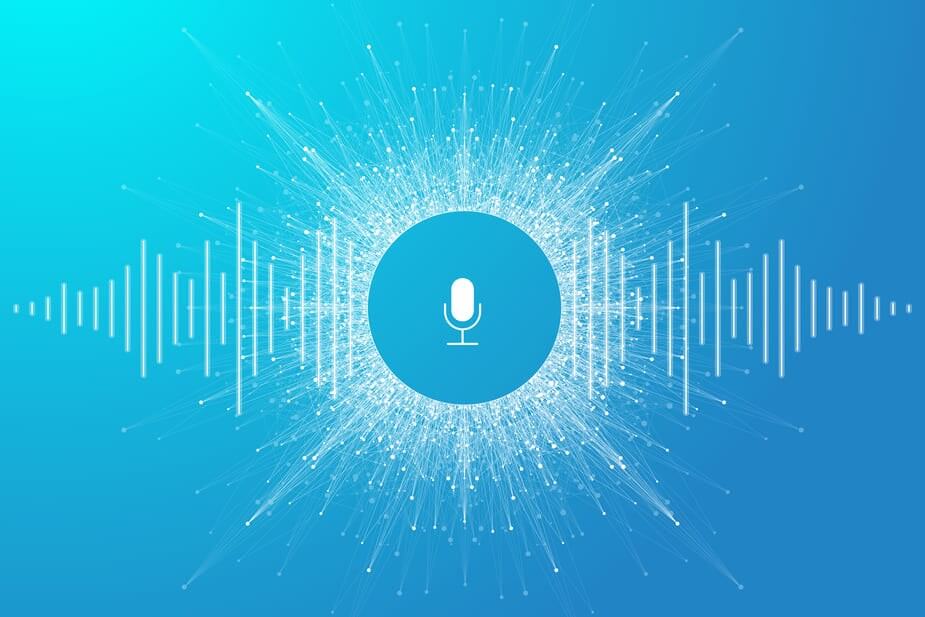Machine-to-human interaction is getting more sophisticated. A while ago, the adoption of touch screens had changed the way we communicate with our devices’ operating systems, and now, the use of voice technology is gaining momentum, propelled by the need to introduce contactless interactions during the COVID-19 outbreak.
The stage for the emergence of voice-enabled devices and interfaces, though, had been set long before the pandemic. Voice technology adoption has been driven to a large extent, by demographic and social factors as our daily lives become increasingly more complicated.
Below, we will give you a brief overview of voice tech use cases, and uncover its business benefits. But first, let’s take a closer look at the existing voice-enabled solutions and how they work. Read on to learn more!
What is voice technology?
Voice processing technology is not entirely new. In fact, computers were capable of receiving voice commands as early as the 1990s, but lacked conversational interfaces. Nowadays, the proliferation of cloud solutions and AI is finally enabling voice recognition technology to fully unleash its potential.
In essence, voice tech is an integration of NLP, cloud computing, wireless networking, speech recognition and other complex technologies enabling us to use voice commands to operate devices and perform internet searches.
Today, the voice recognition technology market is expanding at a 16.8% growth rate and is set to reach $27.16 billion by 2025. About 90% of people report they are enjoying voice search, and 62% of shoppers using voice search say they plan on using it again.
On top of that, there’s a growing trend for the development of Voice User Interface (VUI) software. As experts prophesize, voice interface will become the predominant means of how we interact with devices in the near future. Why reach for the remote to switch to another channel or control the lighting when you can tell your virtual assistant to do it?

Speaking of voice-based virtual assistants, most of the Internet and smartphone users are already well familiar with the following apps:
Siri – built by Apple, Inc., this virtual assistant uses a natural-language user interface and machine learning to perform searches, give recommendations, and communicate with users. It also uses gesture-based controls, apart from voice communication, and comes installed by default in IOS, watchOS, tvOs and other Apple products.
Alexa is an AI-based virtual assistant built by Amazon. Alexa uses voice interactions and performs tasks like setting alarms, assembling to-do-lists, playing music and podcasts, etc. It is also used in home-automation systems and its skill sets can be extended with third-party apps.
Cortana is a virtual assistant built by Microsoft. Cortana can perform a wide range of features and act as a full-fledged assistant: schedule meetings, set reminders, perform a range of sophisticated searches, record personal data and access it on-demand, etc. The assistant can recognize music and notify users about upcoming concerts, find the nearest local attractions, and more.
Google Assistant is a voice app for Android OS. It also comes as a standalone app for iOS. Google Assistant recognizes the human voice, although keyboard entry is also available. This voice assistant can perform voice searches, take notes, set alarm clocks, schedule events, and adjust the device’s hardware settings.
As per the Voice Report by Microsoft, 69% of customers were using voice apps in 2019, primarily, on their mobile phones. In business, 19% of organizations are using voice assistants, and 46% are planning the adoption of voice enabled technology in the near future.
How does voice technology work?
Voice recognition technology is, in essence, the use of digital systems to recognize and authenticate the voice of an individual. The concept of voice recognition is often confused with speech recognition, however, these technologies are distinctly different. While speech recognition technology can understand what has been said, voice tech identifies a speaker via recognizing individual voice specifics and patterns.
An example of speech recognition is a YouTube search feature, enabling users to search for videos using audio input. Voice recognition technologies act similarly to fingerprint identification, helping install highly-personalized locks on a car or a home. Voice-enabled technology is preventing others from using your devices or accessing the information that you want to keep private.

Benefits of voice technology
Initially, the adoption of voice technology has come across a number of challenges. It’s no secret that voice-enabled systems were cumbersome and uncomfortable to use at the early stages of their existence. Today, though, voice processing technology has become a lot more advanced and has all it takes to become a valuable asset for businesses and individuals.
Here’s what the benefits of voice technology can bring to the table:
Fast searches
The reasons why people use voice technologies mostly revolve around the freedom of movement that comes with conversational interfaces. Voice search works faster than manual input, saving time, and enabling users to search for whatever they need on the go or while driving.
No learning curve
Voice User Interface is as intuitive as it can be – rather than us learning how to talk to machines, it’s the other way around – artificial intelligence is learning how to recognize individual voice and understand human language. Moreover, it looks like soon machines will understand even our hidden intentions, as tech giants are already working on AI assistants capable of understanding human emotions.
Creating lists and schedules
With voice-based software, customers can create simple shopping and to-do-lists, schedule tasks, make appointments, etc. Virtual assistants are perfect in organizing daily routines: they remember everything and are instantly available. Electronic reminders and schedulers eliminate paperwork and help handle daily tasks faster and more efficiently.
Accessing apps on devices
Voice assistants like OK Google and Siri can control apps on your devices and perform some complex functions: Searching flights to a specific location, looking for special offers and discounts, booking a doctor’s appointment, or looking up an address in an address book – the range of things they can do is getting increasingly diverse. Amazon’s Alexa, which can act as a digital smart home manager, is a vivid example of how intelligent virtual helpers have become.
Proofreading
Voice-based software can read printed documents back to you so that you can identify and correct errors or inadequacies. Such software generates a robotic voice that reads the text out loud without omitting a word and enabling you to make all the necessary corrections.
Voice apps are transforming our daily lives as well as the business environment. In the next section, we will explore examples of how voice recognition technology is applied in different business segments or industries.

Voice technology use cases
The integration of voice enabled-technologies is underway in many business segments, streamlining a lot of routine operations, and accounting for the introduction of sleeker and smaller devices as well as lighter and more convenient software interfaces. Let’s now take a closer look at voice technology examples in different industries.
Application of voice recognition technology in banking and finance
The finance sector has been among the first ones to recognize the potential of voice tech. Currently, the clients of PayPal, Venmo, and a number of established banks can send payments via mobile personal voice assistants. A lot of financial market players are implementing voiced-enabled services.
For example, Garanti bank has built a proprietary voice based application that clients can use to transfer funds and pay for products by pronouncing a name of a company or a person.
Voice technology examples in healthcare
The healthcare industry has immense potential for the adoption of voice-enabled technology. Eliminating manual entry can help physicians reduce the time it normally takes to input patient data into the EHR system and enable them to see more patients or reach a better work-life balance.
In the patient care segment, voice-enabled systems can help patients take better control of their environment, control lighting and heating, and feel more comfortable during their recuperation period. On top of that, voice-based software streamlines workflows by freeing up the hands of the healthcare professionals, enabling them to easily retrieve patient-related information via voice commands.
Using voice-enabled solutions in education
Before the pandemic, the adoption of voice assistants had been gradually taking place, but the post-pandemic surge in distant and hybrid education has led to the increased use of tools like Alexa or Google Assistant in the classroom.
Voice-enabled solutions can streamline the teacher’s work and automate writing progress reports, sending email assignments, updates and even shopping lists with essential items for homeschooling.

How voice search technology revolutionizes transportation
Voice related technologies are impacting the public transportation sector as well; today, they are already a part of car sharing services like Uber. Voice assistants are also helping citizens across the world receive information about available public transportation routes and schedules.
In the near future, bus and train stops will be equipped with voice interfaces, helping people choose optimal routes to their destinations. On top of that, voice technology fosters inclusions providing a helping hand to the elderly and the visually impaired.
Creating better shopping experiences with voice tech
The retail sector is also reaping the benefits of voice recognition technology. As of today, profits generated for retailers using voice ordering capabilities have reached $2 billion and are expected to grow even more, along with the increasing use of smart home systems like Amazon Alexa and Google Home.
Voice-tech in retail still has a long way to go to fully live up to customer expectations, but it is already transforming the shopping experience as we know it.
Applying voice biometrics to enhance security
Sharing any kind of personal data in the digital era is potentially challenging from the security standpoint. The use of voice biometrics gives companies across all industries a possibility to protect user data using unique voice characteristics like tone and pitch to identify a particular customer.
For example, Swisscom, an EU-based telecom company has implemented voice recognition in its customer call centers to streamline and facilitate real-time user authentication. All in all, the application of voice tech for security protection is a growing trend.
Recording meeting minutes with voice transcription apps
At times, taking exact meeting minutes or having a detailed written record of what has been said can be crucial for business or legal reasons. Voice recognition makes these tasks easier by instantly converting the spoken words into text, which users can quickly e-mail to other meeting participants or store for reference.
Needless to say, transcribing podcasts and making them accessible in the text format is also one of the functions of voice transcription software.

Using voice recognition for real-time translation
Real-time translation is no longer a human-specific skill. Using voice recognition technology, modern video conferencing software can not only automatically transcribe what has been said, but also translate the words into another language and make the translation appear on the screen almost instantaneously.
Learning languages using natural voice recognition is also easier now, since the software can automatically check your language skills and pronunciation.
Applying voice recognition technology in criminalistics
The use of voice recognition technology is equally applicable in both security services and criminalistics. The Interpol is already assembling a database of criminals’ voice clips in order to compare them to voice recordings on social networks to identify offenders. While this is raising rightful privacy concerns, the potential of using voice technology in law enforcement is immense.
Voice assistants in the workplace
Voice recognition technology is entering the workplace, helping workers maximize their efficiency by using keyboardless entry and faster access to information. By using virtual voice assistants, employers and employees can access HR management systems such as Dayforce, schedule meetings and ask for available vacation days. Saleseforce is also looking to integrate voice recognition technology into its ecosystem to enable fast and hands-free data entry.
Application of voice-enabled solutions in the hospitality industry
While the travel and hospitality industry has been facing a crisis in the wake of the COVID-19 pandemic, it’s quickly adapting to new challenges. The use of contactless voice interfaces is not only minimizing the risk of contracting a disease, but also accounting for a faster and easier way to book tickets and make hotel reservations.
The Heathrow Airport (UK), for example, has launched an Alexa extension that passengers can use to see the latest flight updates.
Empowering content marketing and journalistics with voice technology
Dictaphones are outdated now: voice recognition software can not only record what has been said but also automatically convert it into a text format. Content marketing and journalistics is being transformed now that it is possible to simply dictate what you want to say and see the text instantly appear on a screen. Needless to say, it saves precious time and helps reach an unprecedented increase in efficiency.

Final thoughts
Clearly, the adoption of voice technology solutions is just a question of time. In three or five years we are likely to witness the integration of voice-enabled technology into every facet of our lives.
Voice tech opens a doorway of opportunities to software development startups that want to tap into its lucrative potential. While tech giants like Google and Amazon are certainly far ahead in the fields of AI, they have already created ecosystems for building Alexa skills or Google Assistant apps where third party companies can thrive.
As a business looking to enhance your company services with voice technology, you will need a step-by-step approach.
In a nutshell, the steps you will have to take in implementing voice tech will include:
- identifying the niche for integrating voice tech within your company,
- envisioning how you want voice tech to improve your customer experience,
- considering existing voice recognition software and platforms for your business needs, and
- partnering with a reliable development company to bring your solution to life.
At EsternPeak we can help you integrate voice recognition technology into your operations or products. Need expert advice on voice-tech adoption? Contact us now for a free consultation!
Read also:



